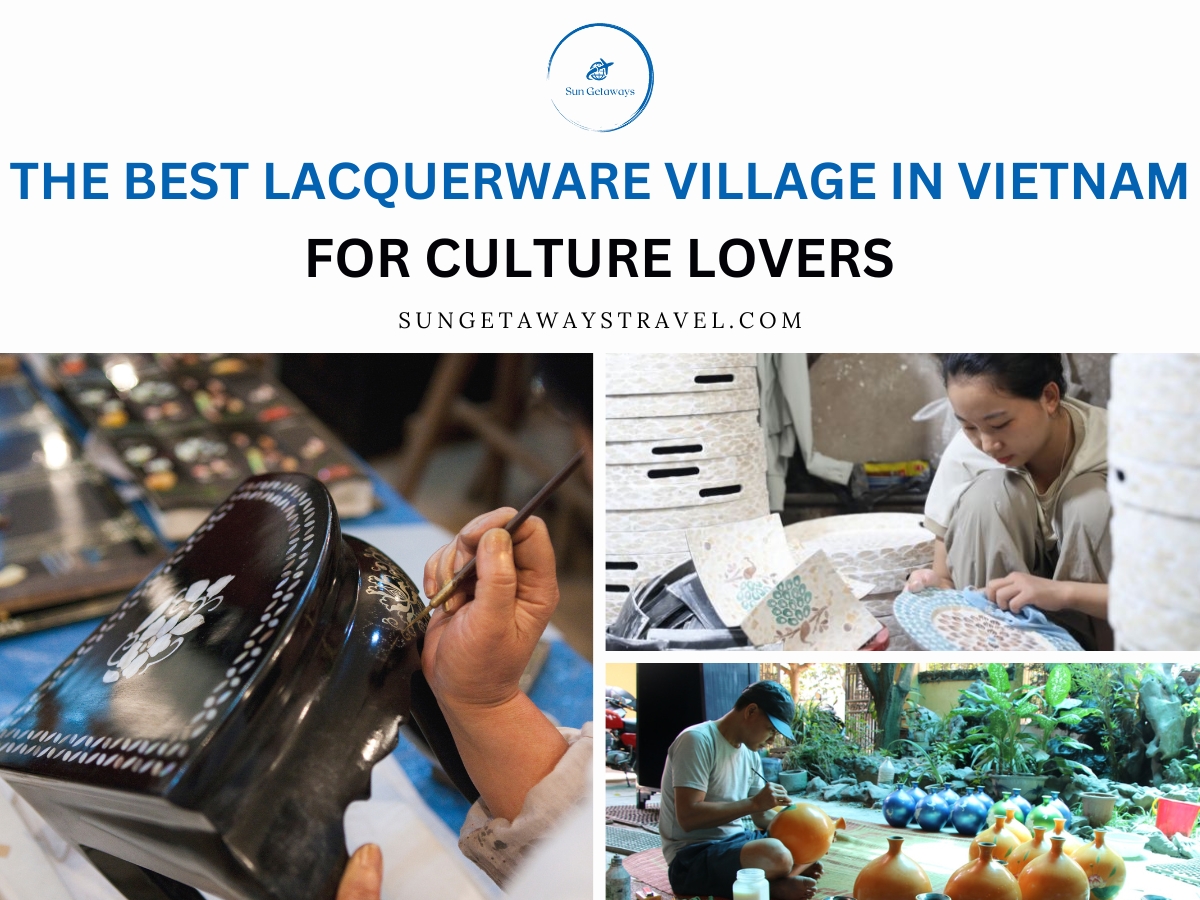The Best Lacquerware Village in Vietnam for Culture Lovers
 PhamDuong
PhamDuong Thinking of combining culture, craftsmanship and travel? Discover a true artisan destination by visiting a lacquerware village in Vietnam, where generations of artisans have shaped the vibrant legacy of the Vietnam lacquer painting tradition. Whether you’re arriving from Europe, North America or Australia, this guide will walk you through history, hands-on experiences, travel tips and how to make this craft visit a highlight of your Vietnam itinerary.
Key Takeaways
- Lacquerware villages in Vietnam like Ha Thai (Hanoi) and Tuong Binh Hiep (Binh Duong) preserve centuries-old craftsmanship, offering travelers a true cultural immersion.
- The Vietnam lacquer painting tradition combines natural “Sơn ta” resin, gold leaf, and eggshell techniques to create artworks of lasting beauty and symbolism.
- Authentic lacquerware should feel smooth, cool, and glassy — travelers should buy directly from artisans to ensure quality and support local heritage.
- Visiting a lacquerware village in Vietnam is more than shopping; it’s a journey into Vietnam’s artistic soul, where culture, creativity, and tradition intertwine beautifully.
1. Historical Origins of Lacquerware Villages in Vietnam
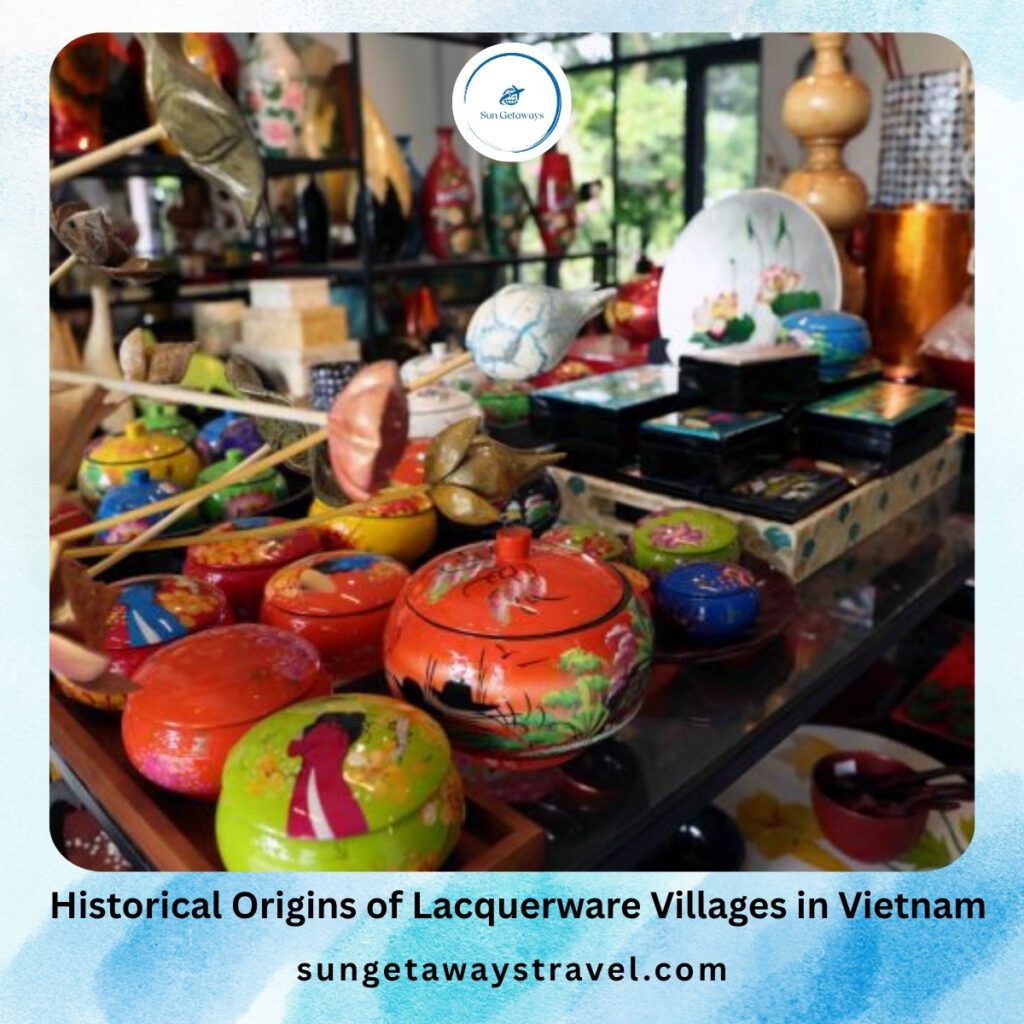

The story of lacquerware in Vietnam dates back more than 2,000 years. Ancient artisans discovered the natural resin of the “Sơn ta” tree, which became the foundation for a durable and glossy finish that defined traditional art and furniture. Over time, the craft evolved from practical coating to a refined artistic expression reflecting Vietnamese spirituality and philosophy.
During the Lê and Nguyễn dynasties, lacquerware flourished as artisans decorated royal furniture, altars, and religious artifacts. The Vietnam lacquer painting tradition gained recognition for its unique combination of layers, textures, and colors achieved through a long process of polishing and curing. By the 20th century, artists like Nguyen Gia Tri elevated lacquer painting to a fine art form that represented Vietnam’s identity to the world.
Today, travelers can explore this evolution firsthand in any lacquerware village in Vietnam, where heritage and innovation coexist beautifully.
2. Famous Lacquerware Villages in Vietnam
Across the country, several traditional villages still preserve the spirit of Vietnamese lacquer. Each has its own techniques, colors, and stories that fascinate visitors eager to learn this ancient craft.
2.1. Ha Thai Village – Lacquerware Villages in Vietnam


Located about 20 kilometers from the capital, Ha Thai is one of the oldest lacquerware villages in Vietnam. Generations of artisans here specialize in decorative boxes, trays, and fine art paintings. Visitors can watch them apply multiple layers of resin and gold leaf, producing deep, mirror-like finishes that shine under natural light.
2.2. Tuong Binh Hiep Village – Binh Duong


Further south, Tuong Binh Hiep near Ho Chi Minh City has been a key center of lacquerware since the 18th century. The village is known for large-scale production while maintaining handcrafted quality. Tourists can tour workshops, meet artisans, and even join beginner-friendly lacquer classes that introduce every stage of the process.
2.3. Cat Dang and Chuon Ngo Villages – Northern Vietnam
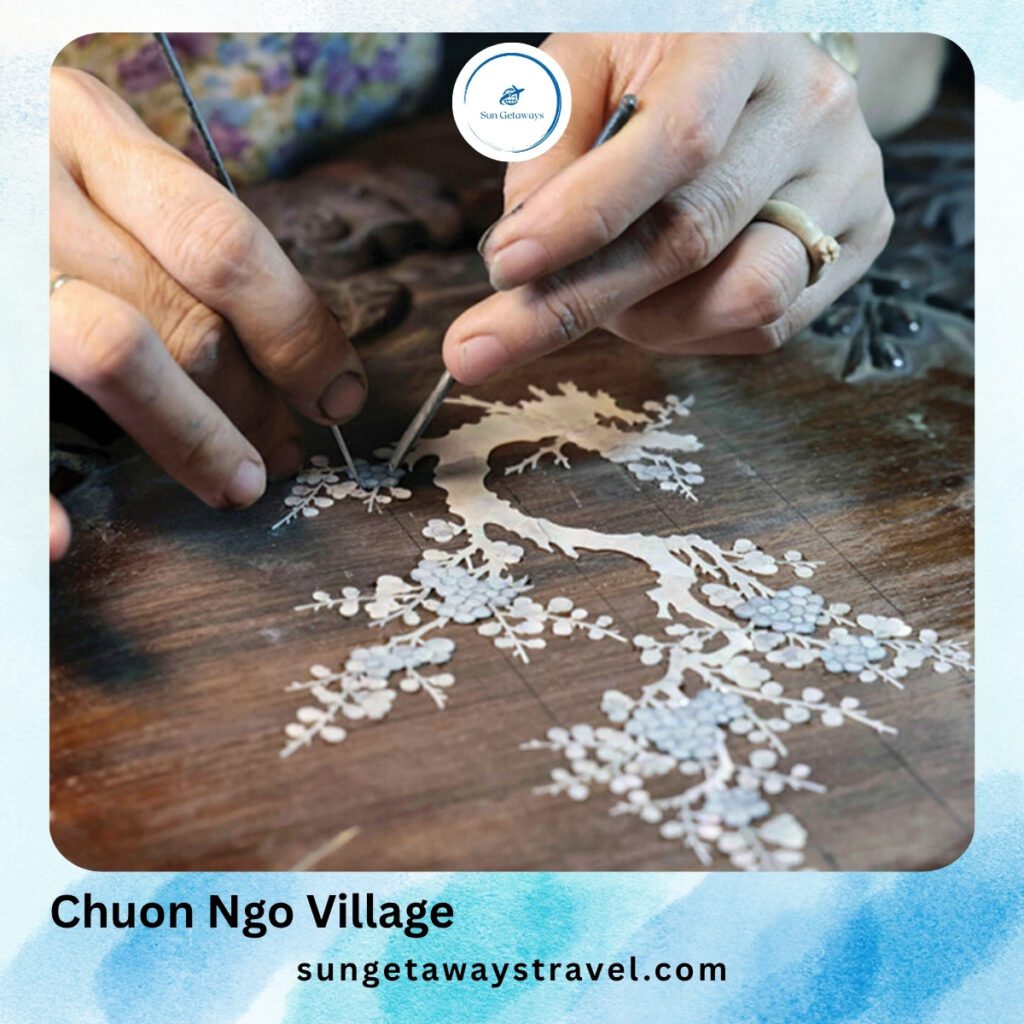

These smaller villages are ideal for those who prefer intimate, authentic encounters. Families here create religious panels and handmade décor for local temples. Besides, the experience gives travelers a close-up view of how the Vietnam lacquer painting tradition remains a living art, passed down within families for centuries.
3. The Art of Lacquer Painting – Process and Symbolism
3.1. Preparing the Base


The first step in creating a lacquer painting begins with selecting a wooden or bamboo base. Artisans carefully coat it with multiple layers of natural lacquer mixed with clay, allowing each layer to dry completely. Therefore, this process ensures a smooth and durable foundation for subsequent decoration.
Additionally, the quality of the base determines how well the lacquer layers adhere and how vibrant the final colors will appear. Traditional techniques are still used in many lacquerware villages in Vietnam, maintaining centuries-old craftsmanship.
3.2. Applying Decorative Elements


Once the base is ready, artisans start the decoration phase. Crushed eggshells, gold leaf, or mother-of-pearl are applied to create depth, texture, and contrast. These elements give Vietnamese lacquer art its signature shimmer and sophistication.
At the same time, natural pigments provide vivid reds, blacks, and golds, carefully layered to enhance visual harmony. Each step demands precision and patience, sometimes taking weeks to perfect a single panel.
3.3. Polishing and Layering
After decoration, multiple lacquer layers are added, each polished meticulously with fine sand and cloth. This creates the glossy, reflective finish that defines Vietnam lacquer painting tradition.
Polishing not only improves aesthetics but also strengthens the artwork. The time-intensive layering process highlights the artisan’s patience and commitment, making each piece a unique masterpiece.
3.4. Symbolism in Lacquer Art
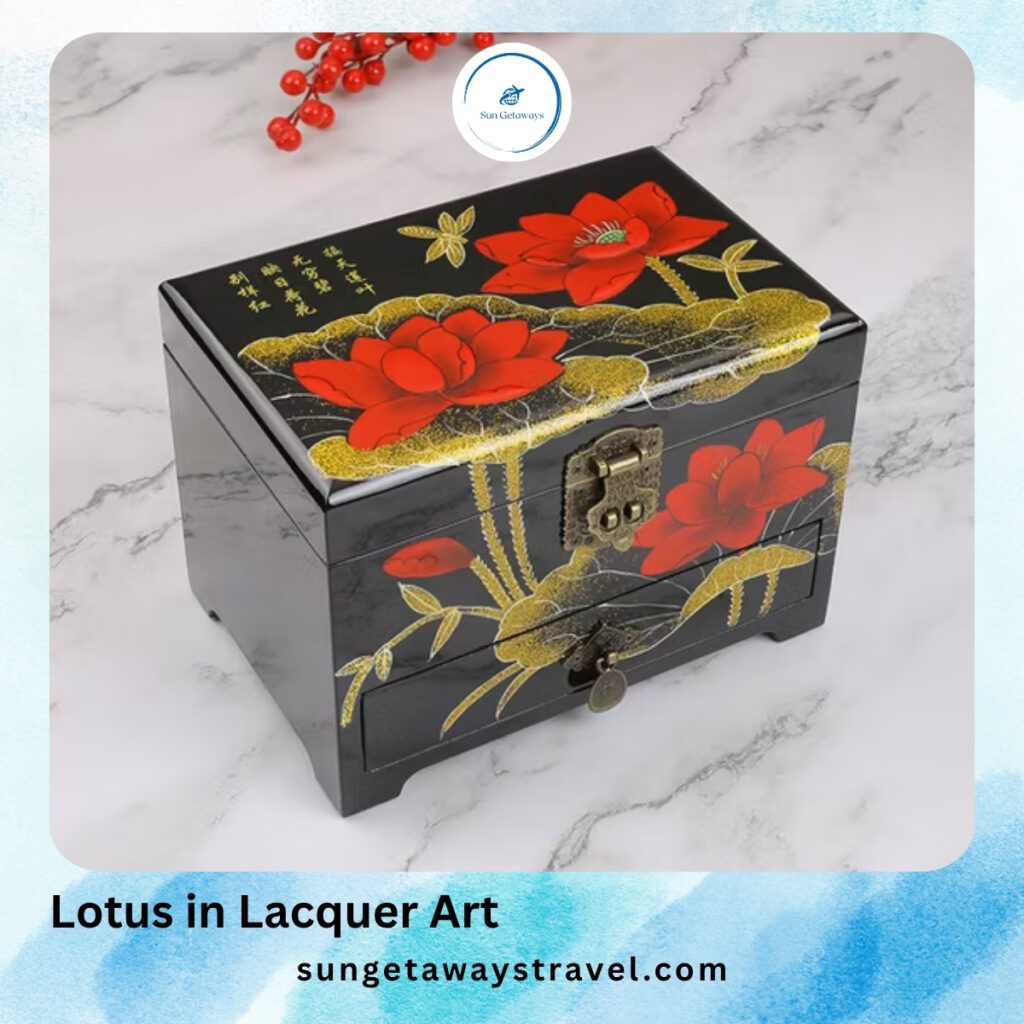

Symbolism plays a major role in lacquer paintings. The lotus often represents purity and resilience, cranes symbolize longevity, and rural landscapes evoke harmony and peace.
Every lacquerware village in Vietnam interprets these symbols differently, reflecting regional culture and personal artistry. Therefore, understanding these motifs enriches the visitor’s experience, turning a simple purchase into a meaningful connection with Vietnamese heritage.
4. Popular Lacquerware Products to Buy in Lacquerware Villages in Vietnam
A visit to a lacquerware village in Vietnam would not be complete without bringing home a piece of its enduring beauty. The variety of lacquerware available caters to all interests, from art collectors to souvenir hunters.
4.1. Traditional Lacquer Paintings
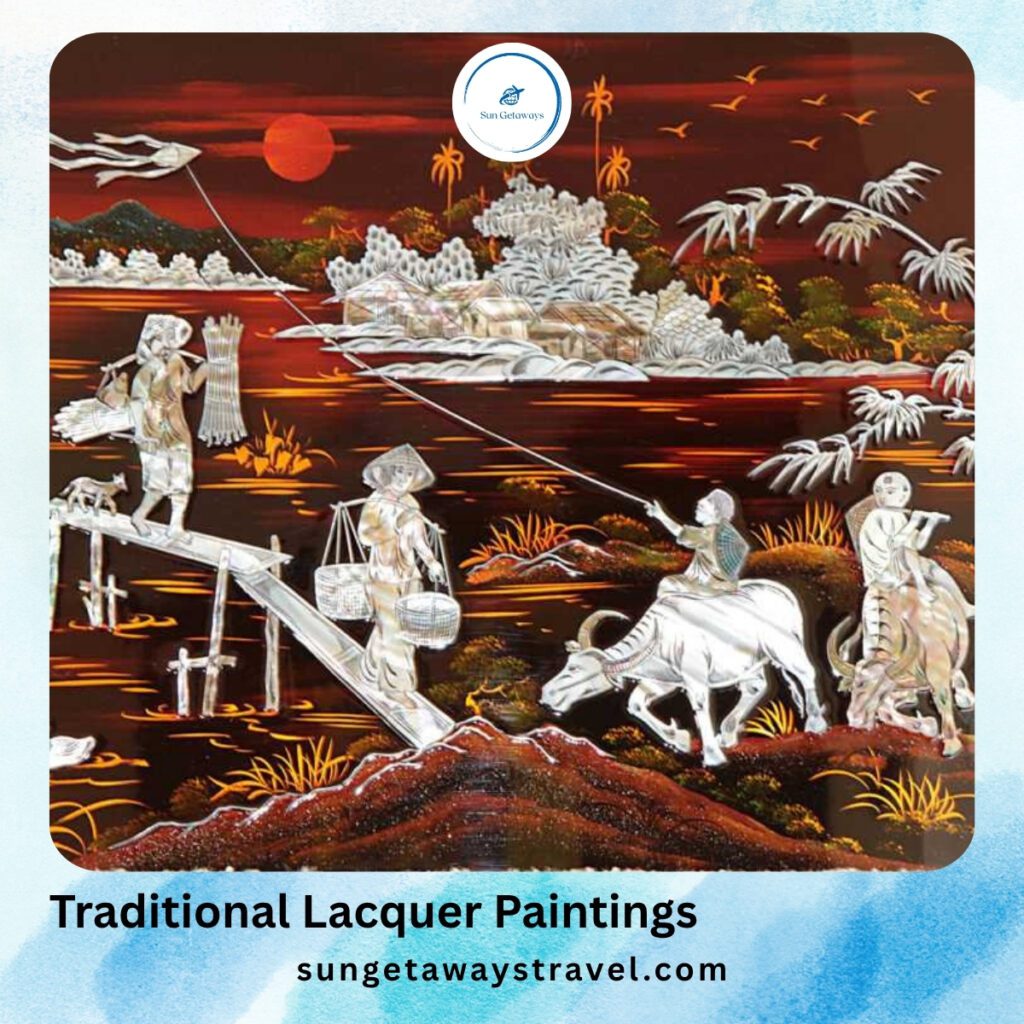

For art lovers, traditional lacquer paintings are the highlight of any lacquerware village in Vietnam. These intricate works depict rice fields, floating markets, and ancient pagodas using gold leaf, eggshell, and natural pigments. In Ho Chi Minh City, several galleries in District 1 and nearby Binh Duong offer stunning collections that reflect Vietnam’s timeless craftsmanship.
Moreover, each piece carries deep symbolism rooted in the Vietnam lacquer painting tradition. Cranes represent longevity, lotuses purity, and village landscapes harmony with nature. Travelers can buy authentic paintings directly from artisans while supporting Vietnam’s enduring artistic heritage.
4.2. Home Décor Items


For those who enjoy interior design, lacquerware makes an elegant and practical choice. Popular items include trays, vases, bowls, and wall panels finished with a brilliant gloss. Additionally, these pieces reflect the refined craftsmanship found in every lacquerware village in Vietnam, where artisans master the balance between art and function. Each creation adds warmth and sophistication to modern homes.
In addition, lacquer décor items are valued for their durability and timeless charm. Unlike fragile ceramics, lacquer can withstand humidity and retain its shine for decades. Therefore, many travelers visiting a lacquerware village in Vietnam purchase these items as gifts or statement décor pieces. You can find premium selections in Dong Ho Village, Hoi An Craft Market, or boutique galleries in District 1, Ho Chi Minh City.
4.3. Souvenirs and Small Accessories
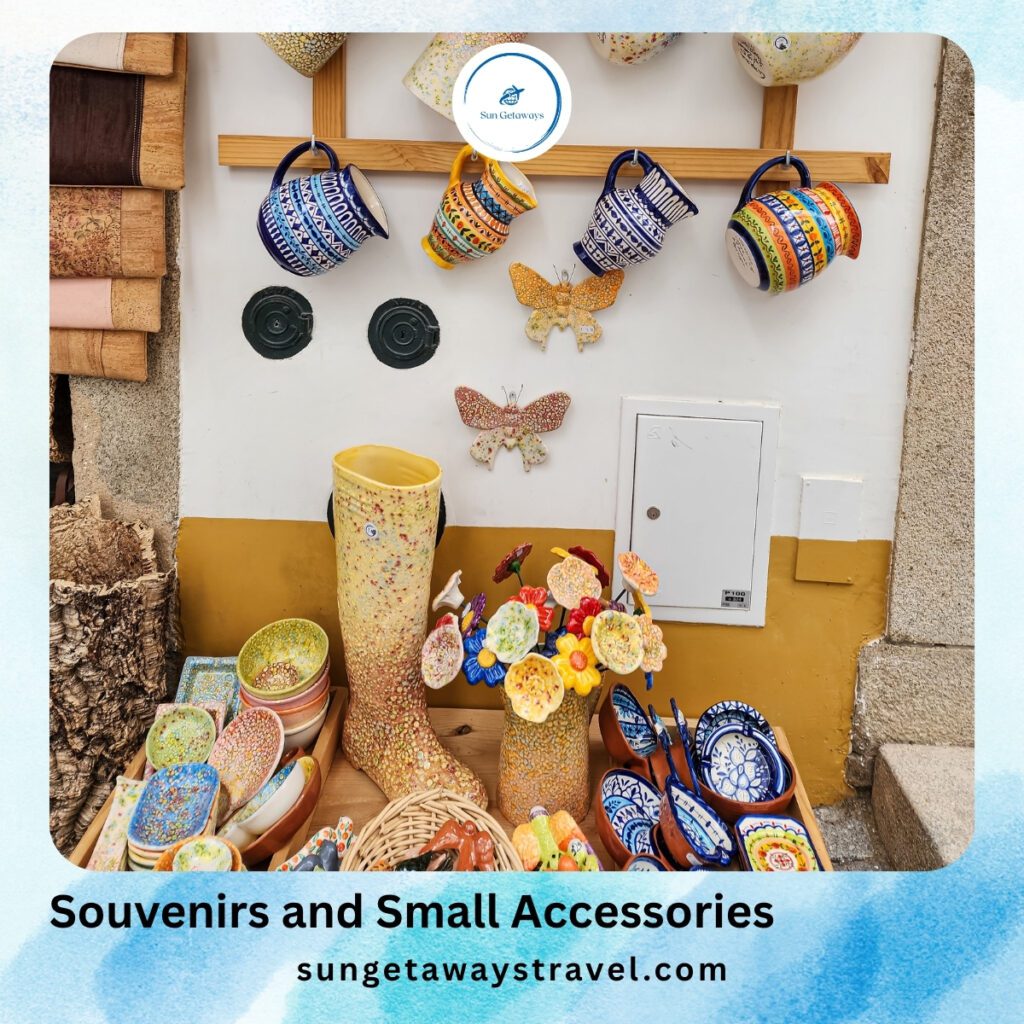

For visitors seeking compact and affordable keepsakes, lacquer souvenirs are a wonderful option. Small jewelry boxes, mirrors, chopstick sets, and coasters are beautifully finished and easy to carry. In addition, each product is carefully hand-polished through multiple layers of lacquer to achieve a smooth, mirror-like surface.
Furthermore, despite their size, these small accessories capture the same artistry and cultural essence as large-scale paintings. With prices typically ranging from $10 to $50, they make thoughtful gifts that represent Vietnam’s craftsmanship. Authentic pieces can be found at artisan workshops in Ha Thai Village or in the charming boutiques of Hanoi’s Old Quarter and Hoi An’s Ancient Town, where visitors can watch artisans at work before choosing their souvenirs.
4.4. Modern Lacquer Creations
In recent years, Vietnamese artisans have given lacquer a contemporary twist, blending age-old techniques with minimalist aesthetics. Modern lacquer creations include elegant wall panels, statement furniture, and even tech accessories like phone cases. Therefore, hese innovative designs appeal to younger audiences and collectors looking for modern interpretations of traditional art.
Beyond their beauty, these pieces represent Vietnam’s evolving identity, a fusion of tradition and creativity. Many local brands now collaborate with young designers to produce limited-edition collections that celebrate sustainability and cultural pride.
If you’re eager to combine art appreciation with travel, consider the Discover Vietnam 9 Days – Hanoi to Hoi An tour by Sun Getaway Travel, which includes guided visits to Vietnam’s most authentic craft villages and workshops.
5. Expert Buying Tips When Visiting a Lacquerware Village in Vietnam
5.1. Identify Authentic Lacquerware
Buying lacquerware in Vietnam is a rewarding experience, yet it requires a careful eye to ensure authenticity. Genuine pieces crafted in a traditional lacquerware village in Vietnam use natural resin known as “Sơn ta”, which is applied in multiple thin layers and polished to a mirror-like sheen.
By contrast, cheaper mass-produced products often rely on synthetic materials that give an artificial shine and tend to peel over time. Always check the craftsmanship carefully before purchasing to ensure you are getting genuine Vietnamese lacquer art.
5.2. Practical Tips Before Buying


Therefore, before making a purchase, travelers should examine the surface for smoothness and depth. Authentic lacquer feels cool and glassy to the touch, while fake versions may have bubbles, uneven coloring, or a strong chemical odor.
It is also advisable to ask the seller about the production process, genuine artisans are always proud to explain their techniques and materials. Taking time to ask questions not only ensures quality but also creates a more personal shopping experience that reflects the charm of Vietnam’s handmade traditions.
5.3. Where to Find Genuine Lacquerware
Additionally, consider purchasing directly from workshops in well-known craft villages such as Ha Thai in Hanoi or Tuong Binh Hiep in Binh Duong Province. Not only do you gain access to high-quality, handmade products, but you also contribute to sustaining the Vietnam lacquer painting tradition that has endured for generations.
These villages often welcome visitors to observe artisans at work, offering both insight and assurance that every piece is made with care, patience, and cultural authenticity.
Ms. Emma Nguyen, Head of Tour Operations at Sun Getaways Travel advises: “When visiting any lacquerware village in Vietnam, take time to talk with artisans. Ask about their process and materials – it’s the best way to understand the real value of each piece.”
Conclusion
The enduring charm of every lacquerware village in Vietnam lies in its blend of heritage, artistry, and human touch. The shimmering layers of lacquer tell stories of devotion and creativity passed through generations. Whether you admire ancient masterpieces in Hanoi, shop for elegant décor in Binh Duong, or join a painting workshop in Hoi An, each encounter deepens your appreciation for Vietnam’s unique cultural identity.
For travelers inspired by craftsmanship and culture, explore custom art and heritage tours designed by Sun Getaways Travel. Every itinerary we create helps you experience Vietnam’s living traditions, beautifully, authentically, and memorably.
Ask a question
Leave a Comment (0)
No questions yet. Be the first to ask a question!









